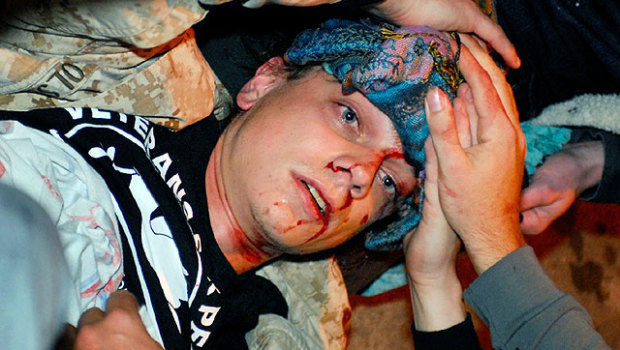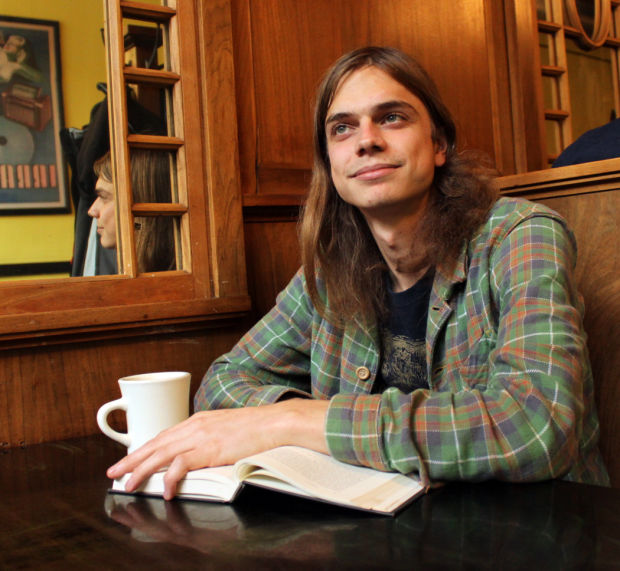Patrons of Jules Coffee House in downtown La Crosse, Wis., didn’t take much notice when they walked past the slender young man with the delicate features and long brown hair.
Seated at a booth last winter perusing a book on the history of the San Francisco Bay area protest movements, nobody seemed to register that the face belonged to an icon of the Occupy movement — probably the most recognizable face of the movement.
Not being recognized was just fine with Scott Olsen, the former Marine who served two tours of duty in Iraq. He didn’t mind keeping a low profile when he came back for a visit, although he decided to go to Jule’s in hopes of getting acquainted with some local radicals.
Most of the world first became acquainted with Olsen’s face from online videos that showed his bloodied face and vacant eyes in the aftermath of being hit in the head by a police-fired projectile during an Occupy Oakland protest.
It happened two years ago last Friday, and it’s an episode in Olsen’s life he’d love to put behind him, but he just can’t yet.
“It’s not like something I really want to talk about all the time,” he said. “I relive it every day. Part of me just wants to stay inside and seclude myself.”
On the two-year anniversary of that fateful protest, though, Olsen didn’t stay inside. Last Friday, he took part in a protest in Oakland against the Urban Shield law enforcement training event that drew police and other emergency responders from around the world.
The training was to help participants be better prepared for handling disasters and large-scale emergencies, whether it be a bombing, a hurricane or a riot. It seems useful enough, but Olsen sees an undercurrent in Union Shield, which also has a weapons trade show, that’s disturbing to him and fellow protesters.
To Olsen, Union Shield contributes to what he sees as the increasing militarization of law enforcement, encouraging a perspective that views the public as the enemy. “Apparently, they’re taught to shoot first and not ask questions later,” Olsen said.
In Olsen’s view, American society and capitalism, in general, is beginning to unravel. “I think people are getting able to see the way the system works, and I think people see the connecting dots of exploitation around the world that’s enabled by the military and keeps our American interests flying for us,” he said.
Serving His Country
Growing up in Onalaska, Olsen’s worldview was far from radical. Soon after he graduated from OHS in 2006, Olsen was in basic training for the Marine Corps, intent on serving in the Middle East.
“I thought our mission was right and good and we were bringing freedom to those people,” Olsen said. “I bought that. I thought it was a very patriotic thing to do.”
The son of a computer expert, Olsen already was good with computers going into the Marines, and he specialized in computer networking serving with an infantry battalion on his first tour in Iraq. “Anything that had more than three blinking lights kind of fell to us,” he said.
Did that mean he spent all his time at a base hammering away at a keyboard? Hardly.
Olsen said he went on plenty of convoys, which he considered the toughest duty. “One of our main missions was driving around looking for bombs on the road,” he said. “It’s just going to get people killed. It’s not helping anybody.”
A lot of lives were wasted in Iraq, and Olsen said a lot of money was wasted, too. The military was paying $250,000, for example, for a couple thousand dollars worth of fiber optic cable.
After his first tour of duty, Olsen said he did not support the war at all, but he said he couldn’t see filing for conscientious objector status, either. He didn’t want to let his brothers in arms down.
Olson came back from his first tour of duty in Iraq with a lingering anxiety about driving and a new view of world affairs. “I definitely got a lot of perspective, empathy for people’s struggles around the world, against occupiers, against imperialism, and that kind of shaped my political views,” Olsen said.
After four years of military service and two deployments, Olsen said he felt as if he and other veterans were just discarded. They were offered little in the way of support in finding their way back to normal in civilian life.
Turning Radical
After his military service, Olsen worked in the Quad Cities for a year, then got a job with a computer software company in San Francisco, moving there with the intention of it being temporary. Even before moving to that longtime counterculture hot spot, Olsen had begun getting involved in “radical” activities.
He went to a couple events in Chicago put on by Iraq Veterans Against the War, very happy to find others who believed the country was traveling the wrong path and felt betrayed and used by their government.
When mass protests sprang up in Madison over Gov. Scott Walker’s “Budget Repair Bill,” which effectively stripped the state’s public workers of their collective bargaining rights, Olsen was drawn to take part, and not just because his sister, Melissa, is a teacher in Green Bay. He spent three consecutive weekends taking part in protests in Madison, sleeping under a bust of the state’s legendary progressive governor, “Fighting Bob” La Follette.
A few weeks after the Madison protests, Olsen got the job offer in San Francisco. In California, he started hearing about Occupy Wall Street, which piqued his interest. When he heard about the Sept. 17, 2011, organizational meeting for Occupy San Francisco taking place only a mile from his office, he went over to get involved, at first as part of an IVAW outreach effort.
Olsen found the Occupy encampment energizing, and besides that, it was preferable to only have to walk a mile in the morning to get to work instead of driving 40 minutes. He spent most weeknights at the Occupy San Francisco camp.
Shot in the Head
After work on October 25, 2011, Olsen heard police had raided the Occupy Oakland encampment and the Occupy participants there had put out a call for support in a demonstration against the police action.
Olsen was at the Occupy Oakland demonstration — not far from the demonstration last Friday against Urban Shield — standing next to another veteran in uniform when he was hit in the head by a “bean bag round,” a bag fired out of a shotgun containing 40 grams of lead pellets. After Olsen hit the ground and fellow protesters swarmed to help him. They pled with officers to get a medic. Instead, an Oakland officer tossed a flash grenade at them.
The videos that show Olsen in the aftermath make it seem like he was pretty out of it, but he said he actually knew what was going on around him. The injury to his brain wouldn’t let him respond to questions, but he remembers the people gathering around him after he got shot, and he remembers walking into Highland Hospital, his arms around the shoulders of a couple fellow protesters.
“I didn’t really understand at the time how hurt I was,” Olsen said. “I thought I was more or less fine.”
He was far from fine. He had a fractured skull, bleeding in his brain and broken bones in his face and neck. He spent two and a half weeks in the hospital, where he had to relearn how to talk.
Olsen’s parents, Tom and Sandy, learned about their son’s injury early the next morning. They got a call about 5:30 a.m. from daughter Melissa, who had learned of the incident from a Facebook post of the harrowing video footage.
Olsen’s parents had a hard getting any information from the hospital over the telephone. “They wouldn’t believe we were the parents because there were all kinds of people who were trying to get information,” Tom Olsen said. “It was a zoo out there, I tell you.”
If they had been able to get a condition report, they later found out, the early expectation was that their son was not expected to make it through the night when he first got there.
Olsen’s parents got a flight to San Francisco out of Madison at 4 o’clock the next morning, and before they got on the flight they learned that their son was off life support and conscious, though he was unable to talk at that point.
It has been a long road to recovery, and Olsen still hasn’t fully recovered. In fact, he might never be the same.
“It sounds like my left frontal lobe is more or less not working any more, which is kind of a drag,” Olsen said, explaining that’s the reason he gets so fatigued by anything intellectually challenging.
Olsen also still has trouble speaking. Words come a lot more slowly for him than they used to.
He tried going back to his old job at the software company for a while, but even 20 hours a week was too much and the company was expecting the old 60-hour-a-week whiz kid.
“I’m mostly working on my lawsuit. That’s my job right now,” Olsen said.
Olsen filed suit against Oakland and it’s police department last December, and he said he thinks he has a pretty good case. Oakland Police Department policy, after all, prohibits the use of bean bag rounds for crowd control and they are not to be fired at anybody’s head or neck, Olsen said.
A settlement conference is scheduled for mid-November, which could bring the lawsuit to a close short of going to trial.
“We’ll see what the city says. They don’t have much of a case anyway. They can’t deny that it was their responsibility,” Olsen said, noting that if no settlement is reached it’ll probably be at least another year before the case is concluded. “I knew it wasn’t going to happen overnight. I knew it was going to be a long struggle.”
When Time magazine gave its Person of the Year honor to “The Protester” a few months after Olsen’s injury, he was probably the most well known protester in the world. He said he thinks he might have sparked a surge of interest in protesting after the incident in Oakland, but he figures it was probably short lived.
“I think in the long term, it probably did decline participation in protests because it’s a very real example of what can happen to you if you attend one of those protests,” he said.
The Occupy movement, in general, has lost its momentum, but Olsen said he thinks some good things came out of it. “It’s definitely changed the way issues are framed,” he said. “It’s brought income inequality to the forefront, and it’s brought the crimes of banks to the forefront.”
Olsen isn’t as involved in political activism as he was before he got shot, focusing on the IVAW’s anti-war cause, but he still goes to the occasional demonstration. “If there’s something going on, it can be a good excuse for me to get out and see people I know and do something productive and meaningful,” he said.
Probably the most meaningful thing he’s working on is the Veterans Tech Collective, an effort he and a friend have launched to help unskilled or homeless military veterans learn IT skills that could help them earn a living.
When his legal affairs have been settled with the Oakland Police Department, Olsen said he sees himself moving back to the area. “I think I can find something productive to do back there in terms of meeting people and building communities that can last after capitalism is over.”
3 WAYS TO SHOW YOUR SUPPORT
- Log in to post comments















